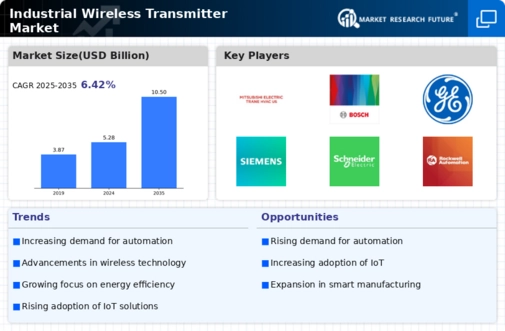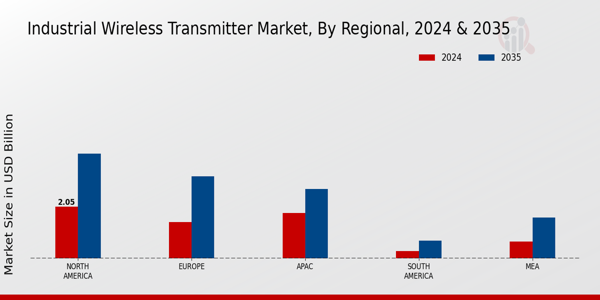Regulatory Compliance
Regulatory compliance is becoming increasingly stringent across various industries, necessitating the adoption of advanced monitoring solutions. The Global Industrial Wireless Transmitter Market Industry is influenced by regulations that mandate real-time data collection and reporting for safety and environmental standards. For example, industries in the chemical sector must comply with regulations that require continuous monitoring of hazardous materials. Wireless transmitters provide a cost-effective solution for meeting these compliance requirements, thereby driving market growth. As companies strive to adhere to regulations, the demand for wireless transmitters is likely to increase.
Market Growth Projections
The Global Industrial Wireless Transmitter Market Industry is projected to experience substantial growth in the coming years. With a market value of 5.28 USD Billion in 2024, it is anticipated to reach 10.5 USD Billion by 2035, reflecting a robust CAGR of 6.43% from 2025 to 2035. This growth is driven by various factors, including technological advancements, increased automation, and the expansion of the Industrial Internet of Things. The market's trajectory indicates a strong demand for innovative wireless solutions that enhance operational efficiency and connectivity across industries.
Technological Advancements
The Global Industrial Wireless Transmitter Market Industry is experiencing rapid technological advancements that enhance the efficiency and reliability of wireless communication. Innovations in sensor technology, battery life, and data transmission protocols are driving the adoption of wireless transmitters across various sectors. For instance, the integration of IoT devices with wireless transmitters allows for real-time monitoring and data collection, which is crucial for industries such as manufacturing and energy. As a result, the market is projected to reach 5.28 USD Billion in 2024, reflecting a growing trend towards automation and smart technologies.
Expansion of Industrial IoT
The expansion of the Industrial Internet of Things (IIoT) is a pivotal factor propelling the Global Industrial Wireless Transmitter Market Industry. IIoT enables interconnected devices to communicate and share data, enhancing operational efficiency and decision-making processes. Wireless transmitters play a crucial role in this ecosystem by facilitating data transmission from sensors to centralized systems. The growing adoption of IIoT solutions across sectors such as manufacturing, logistics, and utilities is expected to drive market growth significantly. With a projected CAGR of 6.43% from 2025 to 2035, the market is poised for substantial expansion.
Growing Demand for Automation
The increasing demand for automation in industrial processes is a significant driver for the Global Industrial Wireless Transmitter Market Industry. Industries are seeking to enhance operational efficiency, reduce labor costs, and improve safety through automation. Wireless transmitters facilitate seamless communication between devices, enabling real-time data exchange and control. This trend is particularly evident in sectors like oil and gas, where remote monitoring is essential. As industries continue to invest in automation technologies, the market is expected to grow, with projections indicating a rise to 10.5 USD Billion by 2035.
Increased Focus on Energy Efficiency
The Global Industrial Wireless Transmitter Market Industry is witnessing a heightened focus on energy efficiency as industries aim to reduce operational costs and environmental impact. Wireless transmitters contribute to energy efficiency by enabling precise monitoring and control of energy consumption in real-time. For instance, in the manufacturing sector, wireless transmitters can optimize machinery performance, leading to reduced energy waste. As companies increasingly prioritize sustainability and energy conservation, the demand for wireless transmitters is expected to rise, further driving market growth.














